Michigan is home to hundreds of spider species, and here you will find around 49 of the most common in the state.
Spiders are extremely abundant around the globe, and in the United States alone there are more than 3,000 different species to be found. Many of the spiders that inhabit Michigan are also found in other parts of the US, and some other parts of the globe.
Some of the spiders in Michigan that you can find include jumping spiders, orbweavers, widows, and cellar spiders.
A spider can be identified by its features, webbing, and behavior. Some spiders are extremely similar, and can only be distinguished from each other by examining minor differences.
While fear of spiders is extremely common, most of the species you come across are harmless. Michigan’s habitats of forest, grasslands, and wetland-type habitats make it a perfect home for the variety of spiders that live in the state.
It is also common for some species to inhabit man-made structures and homes. Let’s take a look at 49 of the most common spiders in Michigan, and the interesting things that can be learned about each one.
Table of Contents
Spiders in Michigan
1. Black Laceweaver
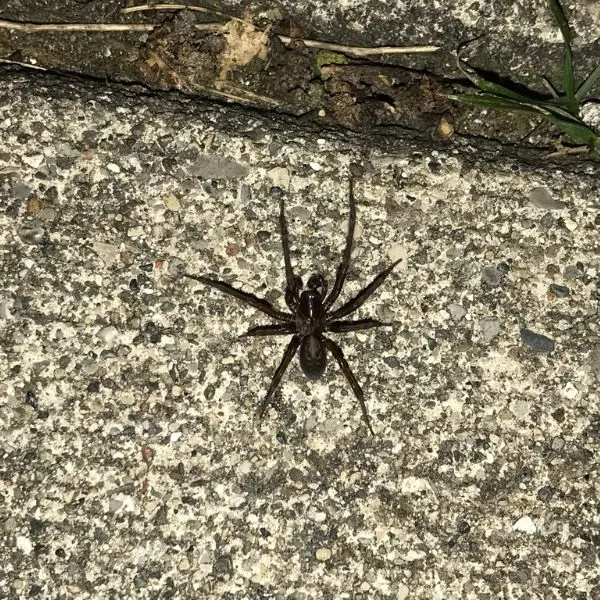
- Experience Level: Intermediate
- Family: Amaurobiidae
- Scientific Name: Amaurobius ferox
- Other Names: n/a
- Adult Size: 8 to 16 mm (0.31 to 0.62 inches)
- Lifespan: 1 to 2 years
- Average Price Range: n/a
Black lace weavers are a spider you can find in Michigan and other areas of North America. This spider is native to Europe and has a wide range spread around the world.
Black lace weavers prefer to live in dark areas like logs and rocks. They are even sometimes found in homes, or other man-made structures like cellars. The name of this spider comes from the web it weavers.
Black lace weavers use wool like silk to make their webs. Their webs are a tangled mess and have a small area to which they can retreat to.
Freshly spun webs from this species are extremely sticky and have a bluish lace-like appearance. This spider is mostly active at night and preys on the variety of small insects that get stuck in its trap.
Females of this species are slightly larger than males, but both sexes look relatively similar. This spider comes in dark shades of black, brown, or reddish brown.
They have a rounded abdomen, with yellow mottled markings on it. Spring to fall is when this spider is active.
Males sometimes find their way indoors, since in the summer they wander to look for a mate. Bites from this spider are generally harmless and reported incidents have said it is similar to that of a wasp sting.
2. Marbled Orbweaver
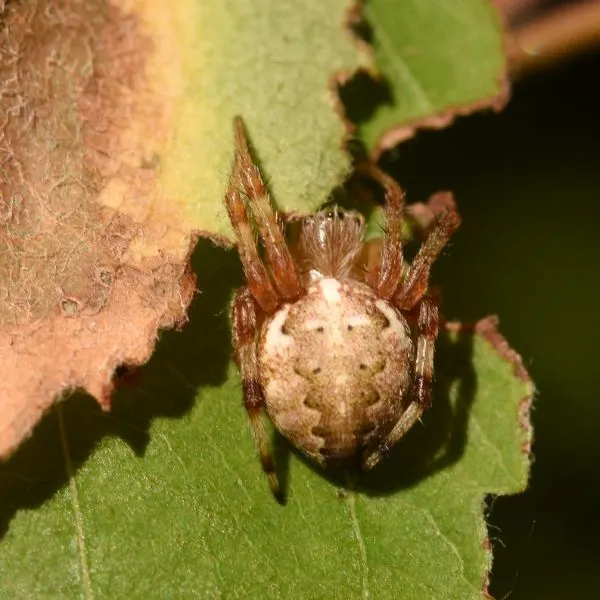
- Experience Level: Intermediate
- Family: Tetragnathidae
- Scientific Name: Araneus marmoreus
- Other Names: Pumpkin spider
- Adult Size: 9 to 22 mm (0.35 to 0.86 inches)
- Lifespan: 1 year
- Average Price Range: $20
Marbled orbweavers are one of the many spiders inhabiting Michigan that belong to the genus of Araneus. This genus is one of the largest in spiders and has more than 1,500 members.
Marbled orbweavers are active mostly in the summer and fall periods. They live in habitats with an abundance of trees, grass, bushes, and other vegetation.
Streams and rivers are also common where they live since they prefer moist areas. Females build large circular webs and hide in a secluded area. They use a string of silk to feel the vibrations of their web and to know when to swoop down on their prey.
Marbled orb weavers get their name from the marbled pattern that appears on their abdomen. Orange, yellow, gray, and tan are some of the colors this spider appears in.
Their legs are spindly and have dark bands running down them. Females are almost twice as large as males and have large rounded butts. Males are slimmer and have a more crab-like appearance.
Females are the creators of the large webs that orbweavers are known for. Male marbled orbweavers usually spend their time looking for a mate and are sometimes seen sitting in their mate webs.
Insects are what this spider primarily feeds on, and they make their webs in areas with high insect traffic. Birds are the main predators that feed on marbled orbweavers, and if they feel threatened it is common for them to drop to the ground out of their web.
3. Cross Orbweaver
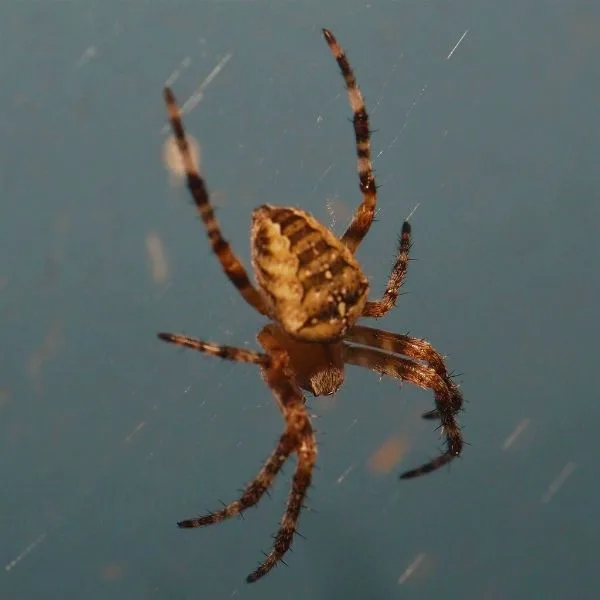
- Experience Level: Intermediate
- Family: Araneidae
- Scientific Name: Araneus diadematus
- Other Names: European garden spider
- Adult Size: 5.5 to 20 mm (0.2 to 0.7 inches)
- Lifespan: 1 year
- Average Price Range: n/a
Cross orbweavers are originally native to Europe but are a species you can find in Michigan and other regions within North America.
Females of this species build large circular webs and are sometimes spotted sitting in the center of their web. Cross orbweavers have built their web in highly vegetated areas or near man-made structures that have plenty of lighting.
This spider is named after the cross pattern that appears on the back of its abdomen. The pattern is white, and they have other white markings on their back.
The color of this species is brown, and they are also covered in yellowish and tan markings. Males are much smaller than females but have longer legs. They have darker colors, but still have the cross pattern on their back.
Cross orbweavers are diurnal and are active from summer to fall. Small insects are what this spider feeds on, and they eat the ones that fall into their web.
This spider rarely bites, but if they do their venom only has extremely mild effects.
4. Tuft-legged Orbweaver

- Experience Level: Intermediate
- Family: Araneidae
- Scientific Name: Mangora placida
- Other Names: n/a
- Adult Size: 5 to 7 mm ( 0.19 to 0.27 inches)
- Lifespan: 1 year
- Average Price Range: n/a
Tuft-legged orb weavers are a species found across the Eastern United States. This spider lives in woodlands, meadows, gardens, and other habitats that are highly vegetated.
Like other orbweavers, this species builds large circular webs. Their appearance helps them blend into woodland habitats, and areas with high leaf litter.
This species has brown or light tan coloring. Their abdomens are white, and they have a mottled pattern covering them.
This spider has long spindly legs that are covered in thick hairs. The hairs on this species are what gives them the tufted appearance. The hairs also make it easier to navigate their web, and lets these species know when something has fallen into their web, and
The web that the tuft-legged orb weaver creates is different from other species within its family. This spider uses fine mesh silk and has much smaller gaps in its webbing to make it easier to catch smaller insects.
Tufted orbweavers are one of the smallest species of orbweavers, and are preyed on by a myriad of predators that live in their habitat. Birds, lizards, and other spiders are some of the animals that eat this species.
5. Fierce Orbweaver

- Experience Level: intermediate
- Family: Araneidae
- Scientific Name: Araneus saevus
- Other Names: n/a
- Adult Size: 9 to 21 mm (0.35 to 0.82 inches)
- Lifespan: 1 year
- Average Price Range: n/a
Fierce orbweavers live across North America and are a species that lives in Michigan. This spider also inhabits areas in Europe and Russia.
Fierce orbweavers live in woodland habitats and are tolerable in colder regions. They are active most from summer to fall and are one of the more rare orbweavers to find. This species is active during the day and builds a large orb-like web in vegetated areas.
This spider ranges in colors from brown to black. They are covered in many thick hairs and have a furry appearance.
On the abdomen of this spider are two humps, as well as cream, black, or tan markings. Fierce orbweavers are one of the larger orb weaver species.
The bite from this spider is not dangerous, even though fierce is in their name. Their fierceness does come out when feeding on the prey that falls into its web.
Fierce orbweavers’ large size makes them prey for animals like birds, which is why sometimes they may retreat to a secluded area to stay unseen.
6. Shamrock Spider
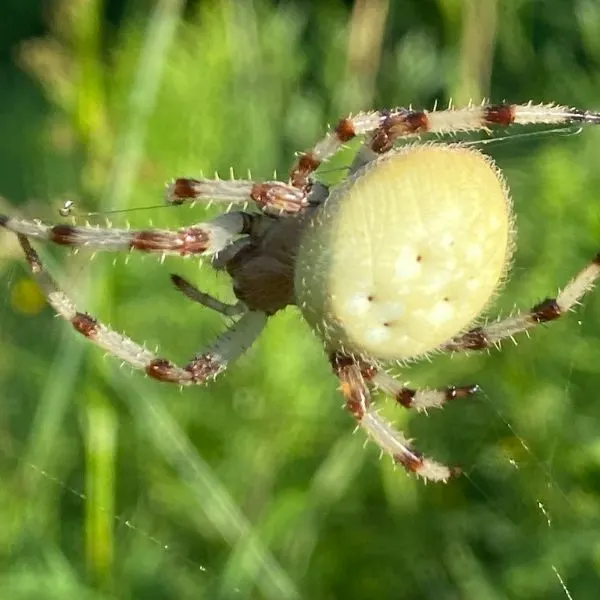
- Experience Level: Intermediate
- Family: Araneidae
- Scientific Name: Araneus trifolium
- Other Names: Shamrock orbweaver
- Adult Size: 19 mm (0.74 inches)
- Lifespan: 1 year
- Average Price Range: n/a
The shamrock spider is a species found across North America. In Michigan, they have a large range all over the state and are most active in the summer and fall.
This spider lives in highly vegetated areas, with plenty of moisture and humidity. Woodlands, rivers, creeks, and marshes are the most common areas this species is found in.
Being an orb-weaving species this spider creates a large circular web to sit in. Their web is made using the vegetation around them for support. This spider will also build its webs on man-made structures like porches, barns, and the sides of houses.
Shamrock spiders have spindly legs and a large bulbous abdomen. Females are large of the sexes, while males have a more crab-like appearance.
White, yellow, red, black, orange, gray, and purple are the colors this species comes in. They have dark bands running across their legs. Small furs cover their body giving them a bristly appearance.
Shamrock orbweavers create a new web daily and eat their silk to recycle it. By creating their webs in moist areas they are able to drink off the small droplets that get caught in their web.
Shamrock orbweavers eat small insects that are caught in their web. This species is nocturnal, feeding on bugs like moths, flies, and mosquitoes.
7. Six-Spotted Orbweaver
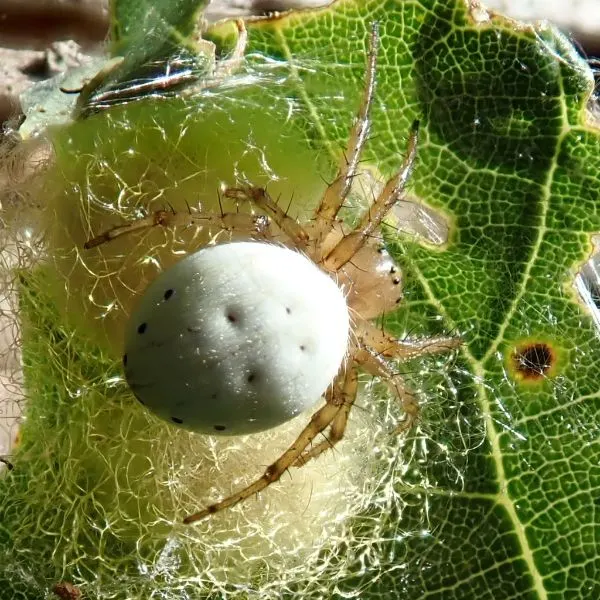
- Experience Level: Intermediate
- Family: Tetragnathidae
- Scientific Name: Araniella displicata
- Other Names: n/a
- Adult Size: 4 to 8 mm (0.15 to 0.31 inches)
- Lifespan: 1 year
- Average Price Range: $20
Six-spotted orbweavers are a species found in North America, but its range also stretches to Europe and Asia. This species is active from late spring to fall, more commonly seen in the warmer periods of the year.
Forests, woodlands, and edged habitats are where this spider lives. Like other orbweavers, they create circular webs to live in, held up by the nearby vegetation.
Tan, orange, yellow, red, and white are the colors this spider comes in. This species is smaller than most other orbweavers.
Small hairs cover their body, and they have a mottled pattern on their body. This spider gets its name from the six spots that appear on the bottom of its abdomen, which have a mottled pattern on it. Small hairs also convert this spider’s body, which helps it navigate its sticky web.
Six-spotted orbweavers use their sticky web to capture their insect prey. Moths, flies, beetles, and plant lice are what this spider preys on.
Being a common species of orb weaver this spider gets eaten by a variety of bird, and lizard species. While their bite may bring some pain, this spider’s venom is not medically significant to humans.
8. Furrow Spider
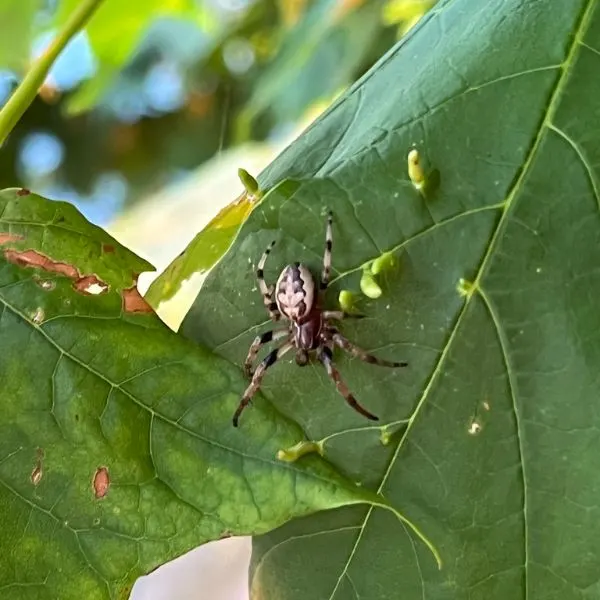
- Experience Level: Beginner
- Family: Araneidae
- Scientific Name: Larinioides cornutus
- Other Names: Furrow Orbweaver
- Adult Size: 10 to 12 mm (0.39 to 0.47 inches
- Lifespan: 1 year
- Average Price Range: n/a
Furrow orbweavers are a common spider in Michigan, living in moist and vegetated habitats. This spider builds large circular webs to live in, oftentimes making them around man-made structures.
Bridges, porches, and the sides of houses are common places this spider builds its webs. Moisture is required in the habitat they live in since they drink the water that collects on their web. Lighting is also used by this spider, making their home near well-lit areas that attract insects.
Brown, tan, gray, and reddish brown are the colors this spider appears in. They have a furrow-like pattern running across their abdomen, which gives them their common name.
This species has thick banded legs, covered in small hairs. Males have smaller abdomen but have long legs.
Furrow orbweavers feed on a variety of insects like mosquitoes, gnats, moths, and flies. They feed mostly on flying bugs and are active at night.
They wait for something to get caught in their web, then ambush them when they feel something trapped. Many keep this spider around when they see them since they are helpful in decreasing the pest insect population.
Predators like wasps, and birds are the main predators of this species. Birds also use the silk of this spider to use it in their nest.
9. Bridge Orbweaver
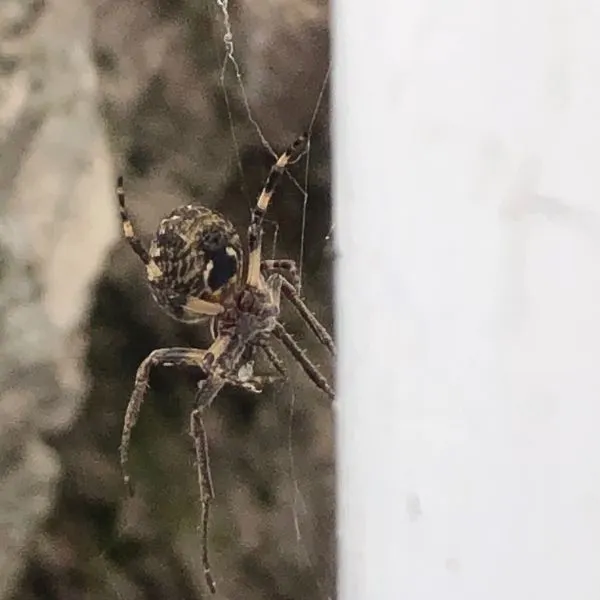
- Experience Level: Intermediate
- Family: Araneidae
- Scientific Name: Larinioides sclopetarius
- Other Names: Gray cross spider
- Adult Size: 8 to 14 mm (0.31 to 0.55 inches)
- Lifespan: 1 to 2 years
- Average Price Range: n/a
Bridge orbweavers are a common spider in Michigan and other states that have Great Lakes. This spider lives in artificial light sources and is common to find near bodies of water.
This species is active from spring to fall but is more commonly found in the warmer periods of the year. In winter most spiders die off but lay eggs for them to hatch the next winter.
Bridge orbweavers build large circular webs to live in, often made near artificial light. Like other species experiences sexual cannibalism.
Female spiders are more likely to mate with aggressive females, but females are larger in size. If females are lacking a food source, feed on the male after mating.
Bridge orbweaver have a tan, dark brown, or grayish coloring. This species is a large member of the orbweaver family, with females being heavier. Males have longer legs and are a bit bigger than females.
This spider is also called the gray cross spider, because of the cross-like blotches that appear on its back. Small furs cover this species’ body, giving them a furry appearance.
Bridge orbweavers live in a variety of habitats, and often build their webs on steel structures. They are mostly active at night and hide in a secluded area during the day.
Flying insects attracted to light are the main food source this species relies on.
10. Hentz Orbweaver
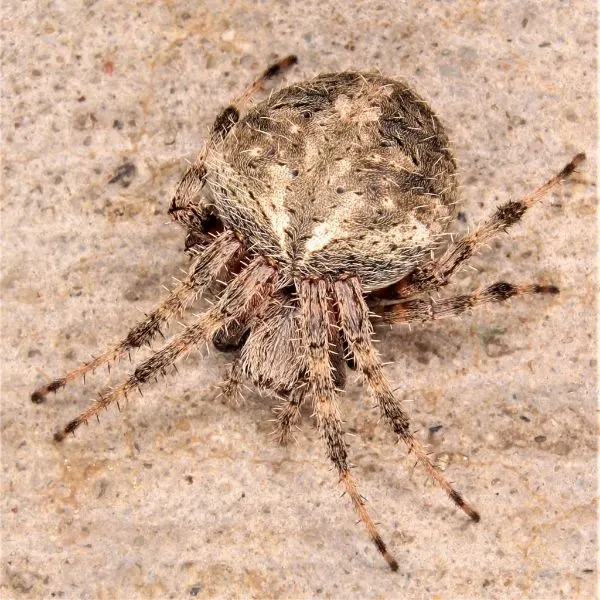
- Experience Level: Intermediate
- Family: Tetragnathidae
- Scientific Name: Neoscona crucifera
- Other Names: Spotted Orbweaver
- Adult Size: 5 to 20 mm (0.19 to 0.78 inches)
- Lifespan: 1 year
- Average Price Range: n/a
One of the most common orb weaver species found in the eastern United States is the Hentz orbweaver. Michigan is a perfect state for this spider, as they prefer to live in moist vegetated areas.
Woodlands near rivers and lakes are habitats this spider can be found in. Late summer to fall is when the Hentz orbweaver is most active. They live in circular webs, attached to the nearby vegetation.
Hentz orbweavers range from light to dark tan in color. Males and females have similar appearances, but females are slightly larger in size.
This species is covered in short thick hair. They have dark markings on their back, as well as red coloring on their legs.
This spider is active at night, and during the day hides in a secluded area. Only females build large circular webs, while males spend their time wandering around looking for a mate.
During the day the Hentz orbweavers hide in a secluded area. They take down their webs every morning, eating their used silk to recycle it.
Insects like moths, flies, and mosquitoes are what this spider eats. They wait for insects to get trapped in their web, and ambush them when they feel something caught in their trap.
11. Orchard Orbweaver

- Experience Level: Intermediate
- Family: Tetragnathidae
- Scientific Name: Leucauge venusta
- Other Names: Orchard spider
- Adult Size: 3.5 to 7.5 mm (0.13 to 0.29 inches)
- Lifespan: 1 year
- Average Price Range: $20
Orchard orbweavers are a spider found in the eastern United States. This spider lives in woodland and forest-type habitats.
Living in highly vegetated areas, the orchard orbweaver is common in orchards, meadows, and grasslands type habitats. Active during the day, the orchard orbweaver lives in circular webs. Their webs are supported by the natural vegetation around, and moist areas are where this species is more common.
Orchard orbweavers have a colorful appearance, with green, yellow, emerald, and silver markings on them. They have an elongated abdomen, with thin legs. Males have a small abdomen, with longer legs than females.
This species is active from spring to fall. In the summer and fall this species mates. Males are not capable of creating a web and spend their time searching around for a mate.
Females lay their eggs hidden in vegetation like leaves or around twigs. When winter comes the adults die off, and the eggs wait to hatch until the next spring.
This spider feeds on bugs like gnats, flies, mosquitoes, and various other pests insects. Orchard orbweavers use their web to catch insects and wrap them up when they get caught in their trap.
Various predators prey on this spider, and when they feel threatened they drop from their web to the ground.
12. Long-jawed Orbweaver
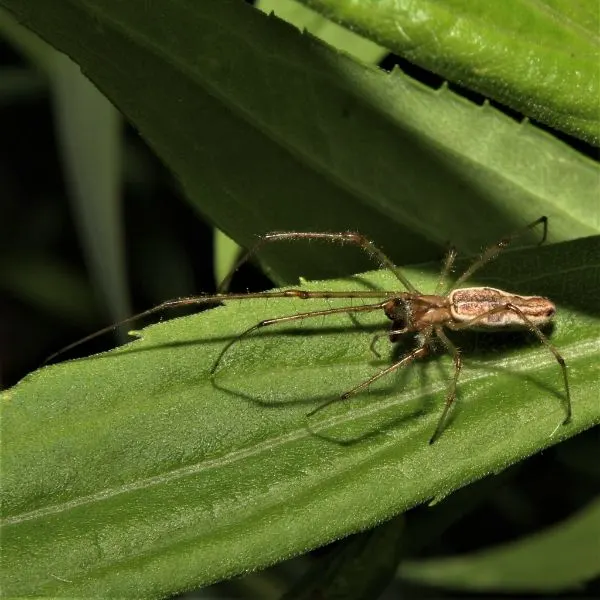
- Experience Level: Beginner
- Family: Tetragnathidae
- Scientific Name: Tetragnatha versicolor
- Other Names: Stretch spiders
- Adult Size: 4.8 to 11 mm (0.19 to 0.47 inches)
- Lifespan: 1 year
- Average Price Range: n/a
Long-jawed orb weavers are a large species living in moist vegetated habitats. This species is found all across the United States. Near ponds, lakes, rivers, and other water sources are where this spider lives.
They live on the web and use the nearby vegetation to support it. This spider may sometimes fall into the water, and they are able to walk across the surface similar to a fishing spider.
Long-jawed orb weavers are tan, grayish, or rusty-colored spiders. This species is named after their long chelicerae. Males have longer fangs than females and use them when mating.
This species has a mottled pattern on its abdomen or dark and light tan coloring. Long-jawed orb weavers have long thin legs, similar to twigs.
This species of orbweaver makes its web right on the edging of water, making it easy for them to capture a variety of insects. Aquatic insects like other flying insects are the main food source of this spider.
Birds, frogs, and fish are the main predators of this spider. Even with their long fangs, this spider is not dangerous. This spider is seen as a benefit since it feeds on the many pest insects that are abundant near the water.
13. Spined Micrathena
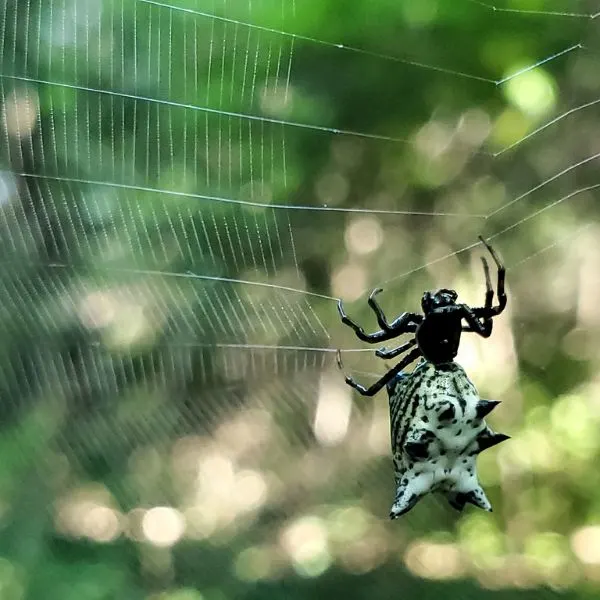
- Experience Level: Intermediate
- Family: Araneidae
- Scientific Name: Micrathena gracilis
- Other Names: Castleback orbweaver
- Adult Size: 4 to 10 mm (0.15 to 0.31 inches)
- Lifespan: 1 year
- Average Price Range: n/a
The spined micrathena is a common species found across North and Central America. This spider lives in moist forested habitats.
This spider lives in orb-like webs but does not stay in them often. They create new webs regularly, moving to new areas.
Michigan lakes and forests are where this spider can be found. In winter this species dies off or becomes dormant. Spined Micrathena is active mostly in the summer and fall.
This spider is named after its spiny appearance. They have a white abdomen, with black spikes protruding from their body. Their abdomen and legs are black and have a shiny appearance. Male spined micrathena are much smaller in size and do not have the spiky appearance.
The spikes on this spider’s body are used to ward off predators. When something messes with them they will curl their legs in, only exposing their spikey body.
Insects are the main food source for this spider. Bites from this species are extremely rare, as they will try to hide or drop to the ground if they feel threatened.
Birds, wasps, lizards, and other spiders are the most common predator this spider faces.
14. Black and Yellow Garden Spider
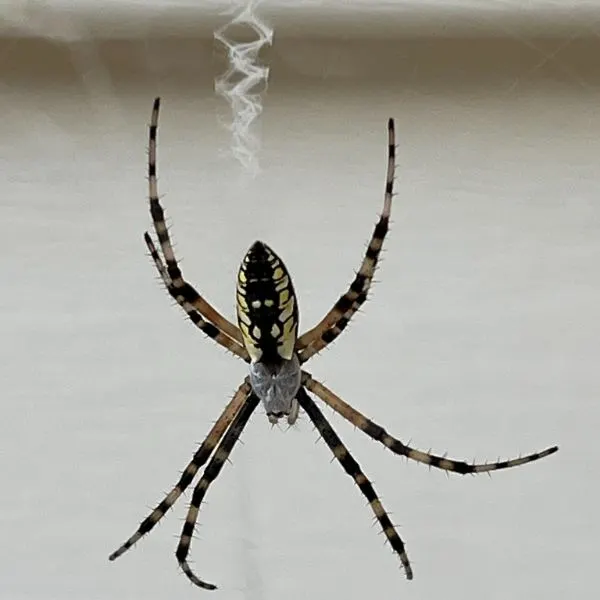
- Experience Level: Intermediate
- Family: Araneidae
- Scientific Name: Argiope aurantia
- Other Names: Yellow garden spider
- Adult Size: 5 to 28 mm ( 0.2 to 1.1 inches)
- Lifespan: 1 year
- Average Price Range: $8
Found all across the US, black and yellow garden spiders are a very common species. This spider lives in fields, gardens, meadows, and type habitats.
The areas they inhabit are highly vegetated, but they may also live on or near man-made structures. Banded garden spiders create large circular webs, but only females create these structures. Their webs can stretch up to 2 feet in diameter and are suspended in the air, held up by the nearby vegetation.
This spider’s web has a zig-zag pattern in its center, called a stabilimentum. This design is thought to help strengthen the structure of its web and make it easier for birds to see. Black and yellow garden spiders are active during the day, mostly seen in the late summer and fall.
Black and yellow garden spiders are named after their black and yellow coloring. Males are much smaller than females, about ¼ of their size
They are often seen sitting in the female’s web waiting to mate with them. Females have a black and yellow coloring, with a white cephalothorax. It is common for this spider to be seen sitting in its web with its head down, making an X shape with its legs.
This species feeds on the insects that get caught in their web. Birds, wasps, lizards, and shrews are what feed on this spider.
While this species is large, it is a harmless spider, and beneficial to the environment it lives in.
15. Banded Garden Spider
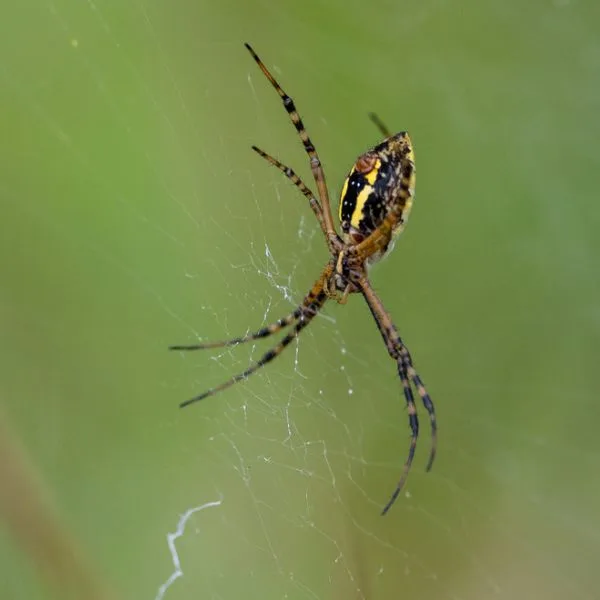
- Experience Level: Intermediate
- Family: Araneidae
- Scientific Name: Argiope trifasciata
- Other Names: Banded orb-weaving spider
- Adult Size: 15 to 25 mm (0.59 to 0.98 inches)
- Lifespan: 1 year
- Average Price Range: n/a
Banded garden spiders live in the US, and are native to North and South America. This spider lives in grassy habitats with plenty of vegetation. Spring to fall is when this species is active.
After mating, they lay eggs and die, and those that don’t mate die when the winter comes. Banded garden spiders live in large circular webs, but only females create these webs.
Banded garden spiders have white, black, and yellow bands running across their body. Males are much smaller than females and have small abdomens and long spindly legs.
Females are more than double the size of males and have a large oval-shaped abdomen. Active during the day, this species is often seen sitting in its web in the shape of a skull and bones.
This species creates a stabilimenta in the center of its web, making its web more stable when things fly through them. These spiders eat flying insects, many of them pests that feed on plants.
This spider is often seen in gardens, and many keep them around to appreciate their beauty and let them control the pest insect population.
16. Bronze Jumping Spider

- Experience Level: Beginner
- Family: Salticidae
- Scientific Name: Eris militaris
- Other Names: Bronze lake jumper
- Adult Size: 4.7 to 8 mm (0.18 to 0.31 inches)
- Lifespan: 6 months to 1 year
- Average Price Range: n/a
Bronze jumping spiders are found in the United States and Canada. This spider is often seen in fields, forests, and residential areas.
Vertical surfaces are where they spend most of their time since it lets them have a better view of their surroundings.
The eyes of the jumping spider are one of the best of all arachnids, and they use their vision to navigate the world. Bronze jumping spiders are diurnal, and at night they make a silken sac to rest in.
Bronze jumping spiders are small in size, with brown coloring. This spider has a mottled pattern covering them of white, and dark brown.
Bronze jumpers have short legs, designed for them to leap. Like other Salticidae this species has two large eyes, with six other smaller ones going around their head. When working together their eyes give them a vision of nearly 360 degrees.
Bronze jumping spiders are active hunters, jumping on the small insects they find. While they may eat other spiders, they prey more often on docile insects like flies, and small crickets.
This species jumps quickly on its prey and stalks it like a cat to look for the moment it can strike.
17. Flea Jumping Spider
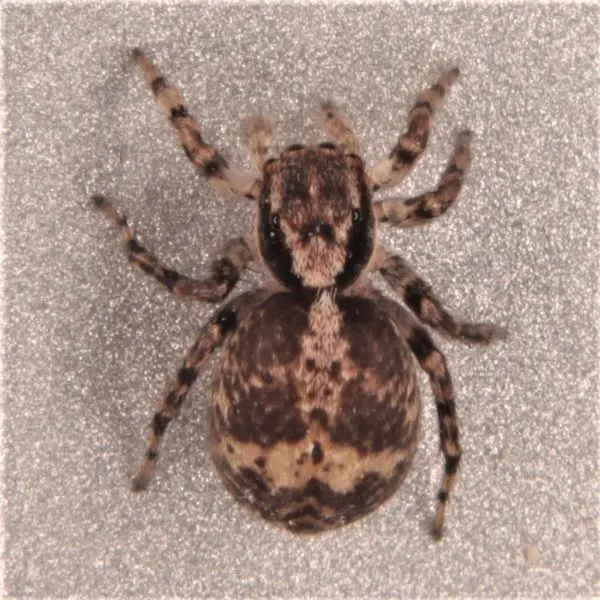
- Experience Level: Beginner
- Family: Salticidae
- Scientific Name: Naphrys Pulex
- Other Names: n/a
- Adult Size: 7 to 10 mm (0.27 to 0.39 inches)
- Lifespan: 6 months to 2 years
- Average Price Range: n/a
Flea jumping spiders live across the Eastern United States, living in wooded habitats. They are commonly seen on vertical surfaces like trees, rocks, and walls.
Flea jumping spiders are active during the day. Spring is when this species is most active. Flea jumping spiders are also found in residential areas, and sometimes even make their way into your home.
This species has a gray and black mottled coloring, with orange on their sides. This jumping spider is a small species and has a large head. They have two large eyes on the front of their face, and legs designed for leaping similar to other Salticidae species.
Flea-jumping spiders feed on small insects. They hunt during the day, and at night they rest in a silken retreat. This species is harmless, and will likely try to flee if approached.
18. Brilliant Jumping Spider
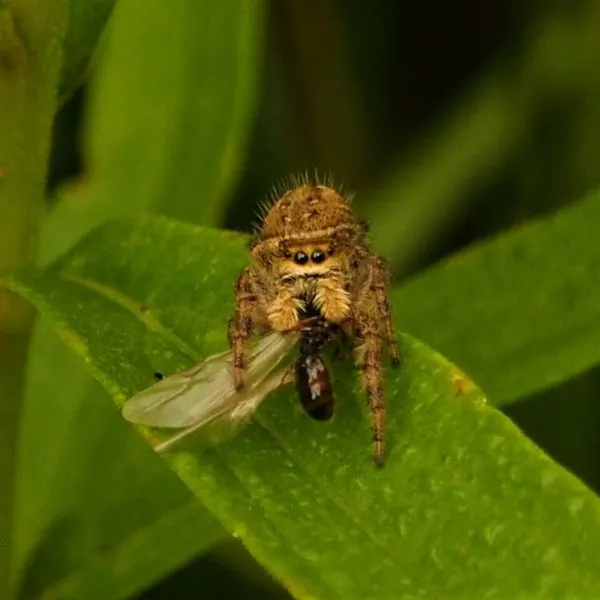
- Experience Level: Beginner
- Family: Salticidae
- Scientific Name: Phidippus clarus
- Other Names: n/a
- Adult Size: 3 to 4 mm ( 0.11 to 0.15 inches)
- Lifespan: 6 months to 2 years
- Average Price Range: n/a
The brilliant jumping spider is a species found in highly vegetated areas. This spider is active during the day and spends its time hunting.
At night like other jumping spiders, this species hides in a silken cocoon. Spring is when this species is most active, spending their time hunting and mating. Males try to woo females by waving their arms.
Brilliant jumping spiders are a sexually dimorphic species. Males are mostly black, with an orange abdomen. They have long legs with white tufts of hair on them.
Females have a large abdomen, with orange coloring. They have tan and orange marking covering them.
The brilliant jumping spider feeds on a small insect they come across in the day. When hunting and jumping around this spider uses silk to tether itself in case it falls.
Since they spend most of their time near plants, this species is helpful in killing off pest insects that may feed on your garden plants.
19. Dimorphic Jumping Spider
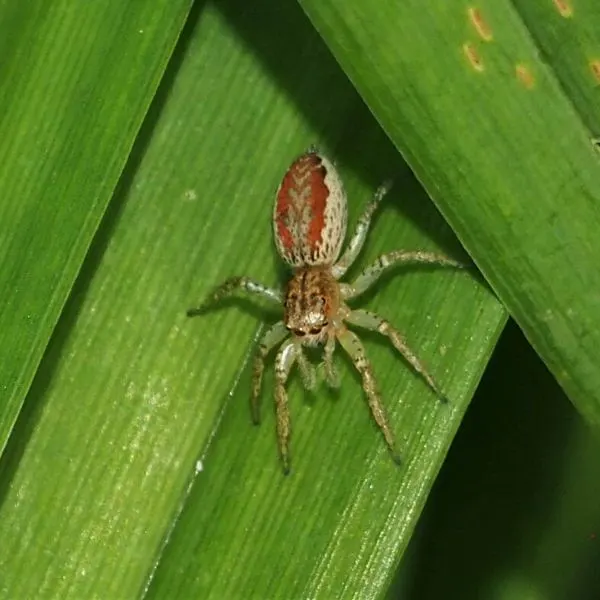
- Experience Level: Beginner
- Family: Salticidae
- Scientific Name: Maevia inclemens
- Other Names: n/a
- Adult Size: 4.75 to 8 mm (0.187 to 0.31 inches)
- Lifespan: 1 year
- Average Price Range: $20 to $30
The dimorphic jumping spider is a species inhabiting the eastern half of the United States.
Gardens, backyards, meadows, and grasslands are the area this species is commonly found. This jumping spider is active during the day and spends most of its time hunting.
Dimorphic jumping spiders will vary greatly in appearance based on their sex, with some confusing them for different species. Males are mostly all black, with tan legs covered in thick hairs.
Females have an orangish color on their abdomen and head, with cream-colored legs. Males also have large pedipalps to help with breeding.
Like other species of jumping spiders The dimorphic jumper leaps at its prey. It can jump great distances for its size and uses a silk tether to move safely from one area to the next.
This spider may also use its silk like a swing, and move in an irregular pattern to escape predators.
20. Bold Jumping Spider

- Experience Level: Beginner
- Family: Salticidae
- Scientific Name: Phidippus audax
- Other Names: Daring jumping spider
- Adult Size: 6 to 19 mm (0.23 to 0.74 inches)
- Lifespan: 1 year
- Average Price Range: $20 to $30
Bold jumping spiders live across the United States and are a common spider in Michigan. Like other jumping spiders this species is active during the day.
During the day they explore the world looking for food, using their long jumps and keen vision to navigate safely. Spring is when this spider is seen the most often, and they stay active until the fall.
Bold jumping spiders are black, with white markings covering their body. Younger spiders may have orange spots on them that turn white with age. On their face are vibrant chelicerae that shine a glossy green.
Bold jumping spiders are commonly kept as pets because of their size, and bold coloring. Being a member of the Phiddipus family they are larger than most Salticidae.
Insects are what this spider eats. They hunt and stalk their prey similar to cats.
21. White-jawed Jumping Spider
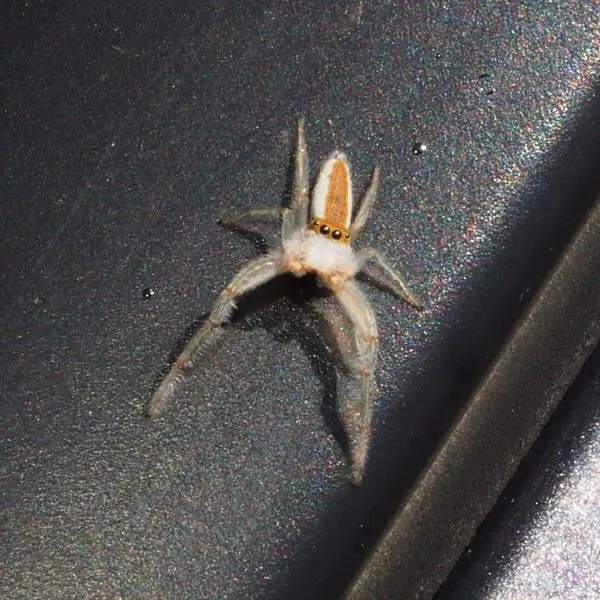
- Experience Level: Beginner
- Family: Salticidae
- Scientific Name: Hentzia mitrata
- Other Names: n/a
- Adult Size: 4 to 6 mm (0.15 to 0.23 inches)
- Lifespan: 1 to 2 years
- Average Price Range: n/a
White jawed jumping spiders can be found in Michigan, and are a common spider across North America. In the US this species is mostly found in the eastern half of the country.
Spring is when this spider is out in abundance. White jawed jumping spiders are often seen in trees, shrubs, and highly vegetated areas.
This spider is white similar to snow. Males and females are around the same size, with a similar appearance.
Females have an all-white mottled coloring on them. Males can be identified by the orange markings on them. Males also have two front legs that are longer than the rest of their appendages.
This spider is active during the day and spends its time hunting. They feed on mosquitoes, flies, and other harmless insects.
This spider prefers smaller insects that have no stingers or pincers, or other ways to damage them.
22. Tan Jumping Spider

- Experience Level: Beginner
- Family: Salticidae
- Scientific Name: Platycryptus undatus
- Other Names: n/a
- Adult Size: 8.5 to 13 mm (0.33 to 0.51 inches)
- Lifespan: 1 year
- Average Price Range: $20 to $30
Tan jumping spiders are common in Michigan and other parts of the US. This spider is diurnal and spends its day jumping from place to place.
They are common on vertical surfaces like fences, trees, and the sides of houses. A small spider, this shy species will flee when threatened.
This spider is tan and covered in small furs. They have a mottled pattern on them and blend well into wooden objects.
The singular legs of jumping spiders help the leap over 6 inches. Tan jumping spiders have excellent eyesight due to the two large eyes, and smaller ones around their head.
Jumping helps this spider escape from predators and also catch its prey. Small insects like flies, aphids, and mosquitoes are what this species eats.
23. Zebra Jumping Spider
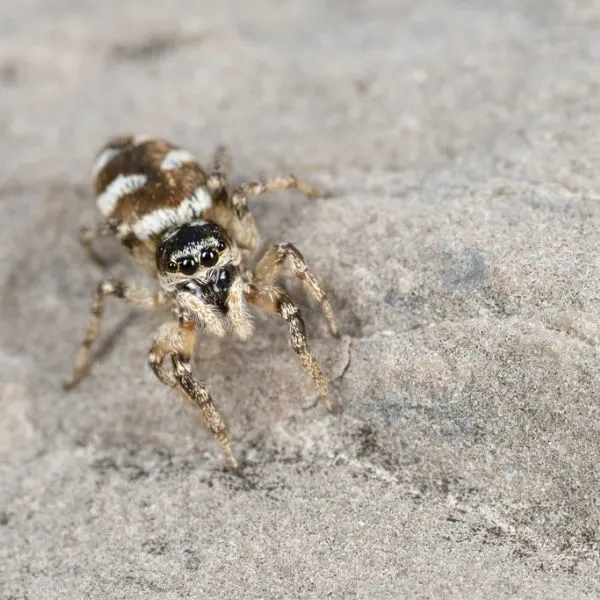
- Experience Level: Beginner
- Family: Salticidae
- Scientific Name: Salticus scenicus
- Other Names: Zebra Spider
- Adult Size: 5 to 9 mm (0.19 to 0.35 inches)
- Lifespan: 1 year
- Average Price Range: $20 to $30
The zebra jumping spider gets its name from the black and white coloring it showcases.
This jumping spider is common in Michigan, as well as other parts of the US. They live in a variety of habitats like grasslands, woodlands, and urban areas, becoming most active in the spring.
Along with its black and white appearance, this spider is covered in small fur. Males and females look very similar, but males have larger fangs.
This species hunts during the day and preys on small insects. It stalks its victims like a cat and waits for the right moment to jump on them.
They have mild venom, but it is harmless to humans. Zebra jumping spiders may feed on other spiders, but will oftentimes try to avoid confrontation.
24. Hacklemesh Weaver
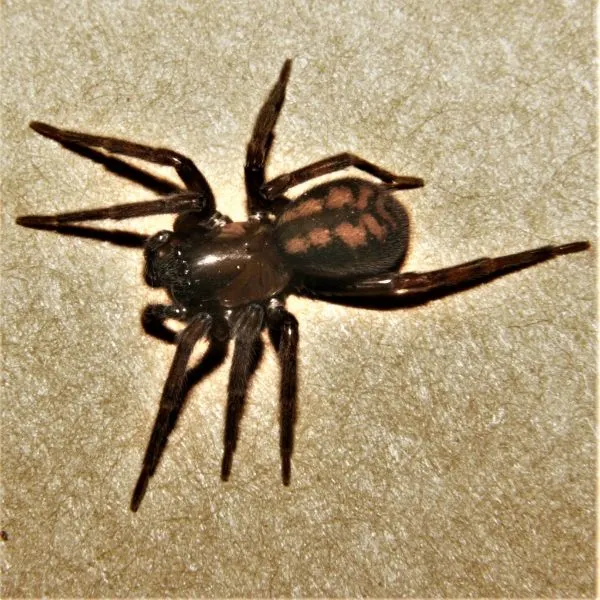
- Experience Level: Intermediate
- Family: Amaurobiidae
- Scientific Name: Callobius bennetti
- Other Names: Tangled nest spider , Bennett’s Laceweaver
- Adult Size: 5 to 14 mm (0.19 to 0.55 inches)
- Lifespan: 2 years
- Average Price Range: n/a
The hackled mesh weaver lives across North America, and in parts of Eurasia. Active from spring to fall, this species spends its time hiding in dark and secluded areas.
The web made by the hacklemesh weaver is messy and spread over surfaces like fences, walls, and other flat surfaces. Their web has a funnel-like entrance, which is where they hide in.
Hacklemesh weaver spiders have reddish-brown coloring. This spider has long thin legs, and a dark mottled pattern covering its abdomen. Their legs are extremely long, helping them travel over their mesh web.
Hacklemesh weavers feed on insects like flies and beetles. They wait for something to get trapped in their sticky mesh web, then quickly pounce on them.
This spider’s bite is not deadly but can cause lasting pain for a few days.
25. American Nursery Web Spider

- Experience Level: Intermediate
- Family: Pisauridae
- Scientific Name: Pisaurina Mira
- Other Names: n/a
- Adult Size: 15 mm (0.59 inches)
- Lifespan: 2 years
- Average Price Range: $10
Nursery web spiders are found all across the US. This species is active from spring to fall, breeding in Summer. Nursery web spiders are known for carrying their egg sac around in their chelicerae.
Up to 100+ eggs are laid by females, and they watch them until they are ready to fend for themselves. Males attempt to mate by offering the female a gift before breeding.
The Nursery web spiders look similar to wolf and fishing spiders but are more slender. This spider has a tan-mottled coloring. Their abdomen is pointed, and their legs stretch out the sides of their body.
Nursery webs wander around looking for food, instead of using a web to catch their prey. This spider feeds on small insects, and small invertebrates.
Nursery web spiders hunt in highly vegetated areas at the night. Their venom is harmless to humans but is useful in taking down their prey.
26. Dark Fishing Spider
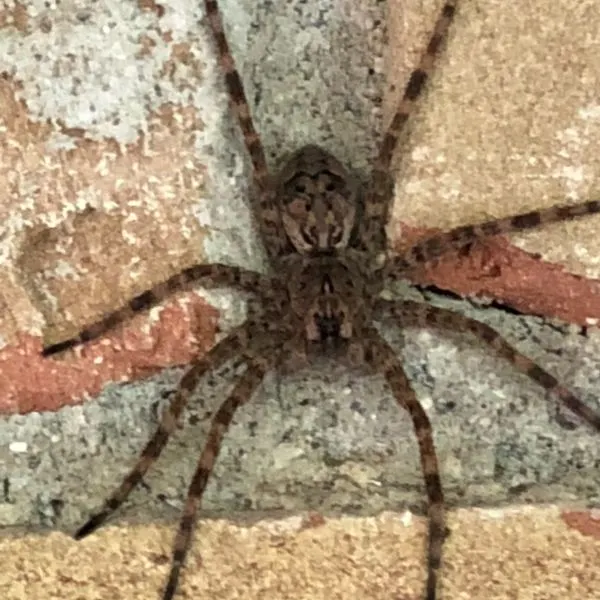
- Experience Level: Intermediate
- Family: Pisauridae
- Scientific Name: Dolomedes tenebrosus
- Other Names: n/a
- Adult Size: 6.8 to 25.4 mm (0.27 to 1 inch)
- Lifespan: 2 years
- Average Price Range: n/a
Dark fishing spiders are a common spider in Michigan, living around moist woodland habitats.
Fishing spiders are nocturnal and spend their day hiding under natural debris. Spring to late fall is when this spider is most active.
Dark fishing spiders are medium to large in size. They can easily be confused for a grass or wolf spider.
This species has dark tan coloring, with hairs covering them. Their hairs are essential for them to submerge themselves in the water safely.
Dark fishing spiders feed on aquatic animals or prey they find on land. They use the walk they walk on as a means of finding foot, as well as protection.
This species is fearful of humans and will try to flee if spotted. Their bite is painful, but the venom they deliver is harmless.
27. Six-Spotted Fishing Spider

- Experience Level: Intermediate
- Family: Pisauridae
- Scientific Name: Dolomedes triton
- Other Names: Dock Spiders
- Adult Size: 15 to 60 mm (0.59 to 2.3 inches)
- Lifespan: 2 years
- Average Price Range: $20
Six-spotted fishing spiders live all across North America and can be found in Michigan. This spider lives around freshwater and is known to walk over the water’s surface.
Woodlands next to lakes, or ponds are where this species is usually seen. Six-spotted fishing spiders are able to walk on water because of the low tension their legs put on the water, and their body is waterproof.
The six spotted fishing spider colors range from gray to brown, and they have two cream stripes that run down their sides. Spots are present on this spider’s abdomen, but they are named after the six spots that appear on the bottom of their belly.
Juvenile fishing spiders are extremely small, but look similar to their adult form. This species showcases sexual dimorphism, and females are larger than males.
Fishing spiders feed on aquatic and semi-aquatic animals. Small fish, tadpoles, water bugs, and small frogs are some of the things they eat. They are able to successfully kill prey around 5 times their size.
28. Striped Fishing Spider
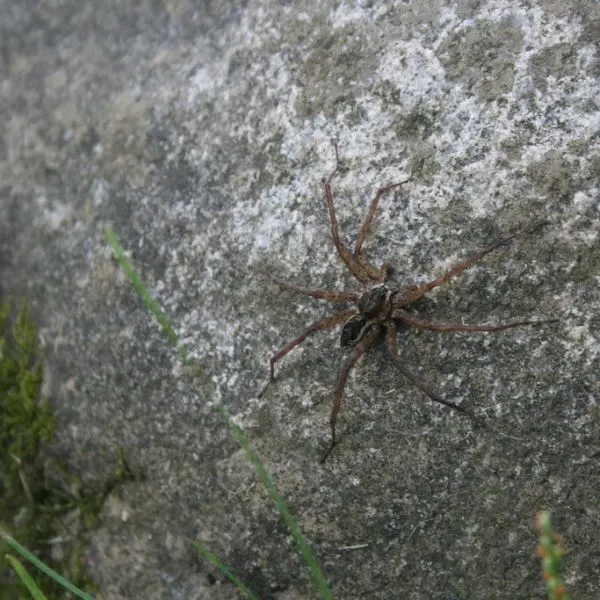
- Experience Level: Intermediate
- Family: Pisauridae
- Scientific Name: Dolomedes scriptus
- Other Names: n/a
- Adult Size: 15 to 60 mm (0.59 to 2.3 inches)
- Lifespan: 2 years
- Average Price Range: n/a
Striped fishing spiders live in moist woodland habitats. They are common in Michigan near the state’s variety of freshwater sources.
Striped fishing spiders are active from the spring to fall, and are a nocturnal species. Dark fishing spiders are commonly seen resting near the edge of a freshwater source. This spider is able to walk on the surface of the water and is a semi-aquatic species.
When this spider lays its eggs, females are sometimes seen carrying the sac in their mouths. This spider is a member of the Pisauridae, which are nursery web spiders.
Striped fishing spiders lay eggs until the winter, and as the temperature gets cold they begin to die off. The eggs and your spiderlings that have hatched overwinter until the next spring comes.
Striped fishing spiders have tan, gray, or dark brown coloring. On their abdomen, they have W-shaped markings covering them.
This species has a mottled pattern covering its body. Stripes run down this species’ legs and the sides of their body.
Fishing spiders feed on aquatic and terrestrial insects. They may even feed on fish and tadpoles.
This spider walks on water to hunt but also uses the water to escape. Striped fishing spiders are extremely skittish, and usually, run if they are approached.
29. Tiger Wolf Spider
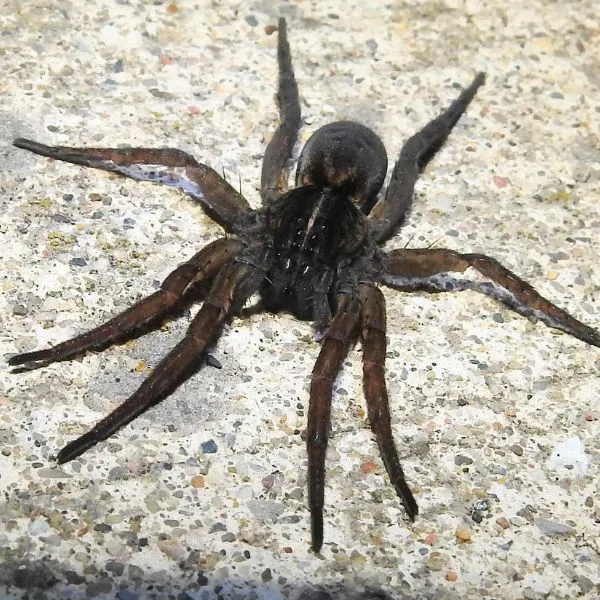
- Experience Level: Intermediate
- Family: Lycosidae
- Scientific Name: Tigrosa helluo
- Other Names: Woodland Giant Wolf Spider, Wetland Giant Wolf Spider
- Adult Size: 13 to 21 mm (0.511 to 0.82 inches)
- Lifespan: 1 to 4 years
- Average Price Range: $20 to $40 dollars
Tiger wolf spiders are a large spider in Michigan, and one of the wolf spiders found in the state.
Forests and grasslands habitats are where this spider inhabits. Tiger wolf spiders live in highly vegetated areas and are ground-dwelling species.
Tiger wolf spiders are large and hairy. This species is brown and has orange bands covering its body. This spider’s body is robust. They have a tannish coloring, which helps them blend into the ground.
Tiger wolf spiders are nocturnal hunters, feeding on any insect they come across. This spider is an ambush hunter, getting its name from its wolf-like hunting ability.
Tiger wolf spiders have large fangs capable of producing a painful bite. Their venom is harmless to humans but useful in taking down its prey.
30. Beach Wolf Spider
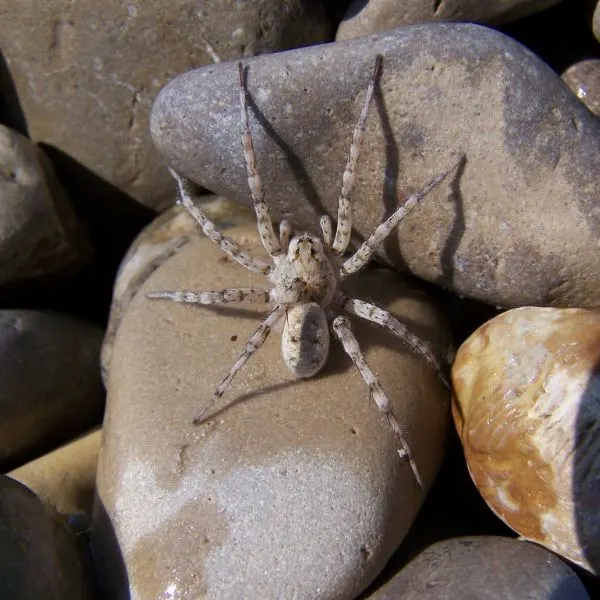
- Experience Level: Intermediate
- Family: Lycosidae
- Scientific Name: Arctosa littoralis
- Other Names: Sand wolf spider, Shoreline Wolf Spider
- Adult Size: 10.9 to 14 mm (0.43 to 0.59 inches)
- Lifespan: 1 to 4 years
- Average Price Range: n/a
Beach wolf spiders live across the United States and are a species active from spring to fall. While associated with sandy regions, this species lives in a variety of habitats.
Warm areas with water are where this species is often found. They are active day and night. When not active they hide under leaf litter, rocks, logs, and in burrows.
Wolf spiders are an aggressive species, and females often kill males when mating. Unlike other wolf spiders, this species does not carry its egg sac.
It does watch their sack in a secluded area. When their spiderlings hatch, they stay on the mother’s back for around 2 weeks.
The beach wolf spider is one of the largest species of Lycosidae in Michigan. It has tan coloring, and a mottled pattern covering it.
Their body is similar to that of the texture of sand, and they are able to camouflage well into that habitat. Small hairs cover this spider’s body, and they have dark bands running down their legs.
Beach wolf spiders feed on a variety of insects and small invertebrates. They feed on anything they come across if it is safe to eat.
Wasps are the main predator this species faces, feeding on them, and laying eggs in them.
31. Brown Recluse
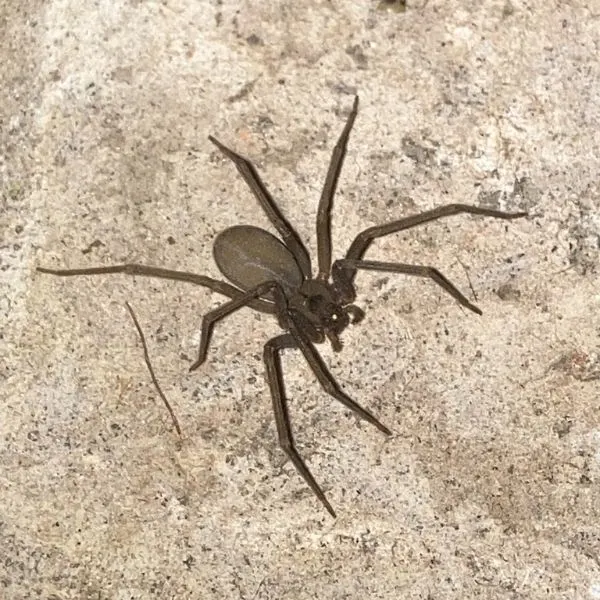
- Experience Level: Intermediate
- Family: Sicariidae
- Scientific Name: Loxosceles reclusa
- Other Names: Violin spiders
- Adult Size: 7 mm (0.27 inches)
- Lifespan: 1 to 2 years
- Average Price Range: n/a
Brown recluses are most common in the US in States like Nebraska and Texas. In Michigan, this spider only has a very small range, in southern Michigan.
This spider is known for its necrotic bite and is a feared species. The brown recluse has very potent venom, and bites cause a variety of painful symptoms. If bitten by this species, medical treatment is needed.
Wetlands, rocky fields, and woodlands are the most common habitats of this species. This spider is active from spring to fall. They often make their way into human homes, but in Michigan that is not an issue since their range in the state is not near residential areas.
Brown recluses have tan coloring and are identifiable by the dark violin pattern that runs down their body. Their legs are long and thin, stretching out the sides of their body.
The brown recluse is a nocturnal spider, hiding in dark secluded areas during the day. At night this spider spends its time hunting, wandering around looking for food.
Insects are what this spider eats, chasing them down to inject them with their venom. Even with its bite this spider still faces predators like lizards and wasps.
32. Northern Black Widow
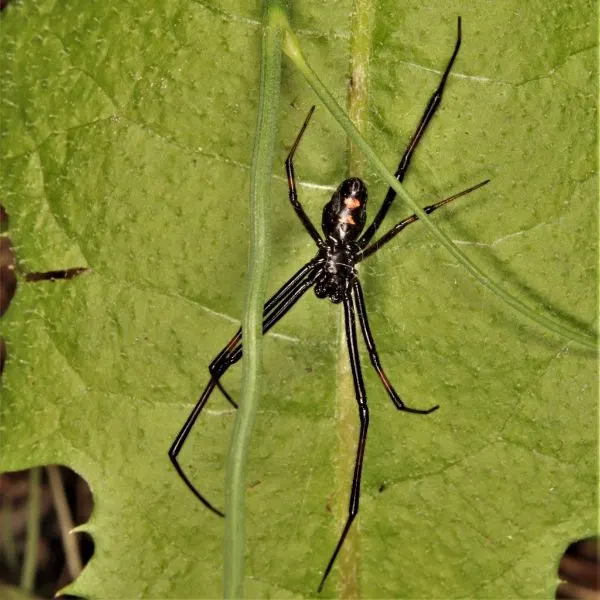
- Experience Level: Intermediate
- Family: Theridiidae
- Scientific Name: Latrodectus variolus
- Other Names: Northern Widow
- Adult Size: 12.7 to 15.24 mm (0.5 to 0.6 inches)
- Lifespan: 1 to 3 years
- Average Price Range: $20
Northern black widows are found in the eastern United States. In Michigan, this spider is found across the state but is more common in the western part of the state.
This spider lives in dark and secluded areas. Logs, animal burrows, sheds, and other tucked area areas are where this spider lives. Summer and fall are when this species is most active.
Northern black widows have a similar appearance to other black widows. They are dark black, with a red hourglass on their belly.
The back of their abdomen also has red markings running down it. The markings on their body can also appear in orange, white, or yellow coloring.
This species has a large abdomen, with long skinny legs. Males are much smaller in size with long legs. Red and white markings cover their abdomen.
Northern black widows have a venom that affects the nervous symptom. Getting bit you may experience major symptoms like vomiting, body pain, swelling, fever, and tremors.
Northern black widows live in messy webs they create. Their eyesight is poor, and they use vibrations from their silk to sense things.
When insects get caught in their web they use the silk to track them and wrap them up in a cocoon.
33. Southern Black Widow
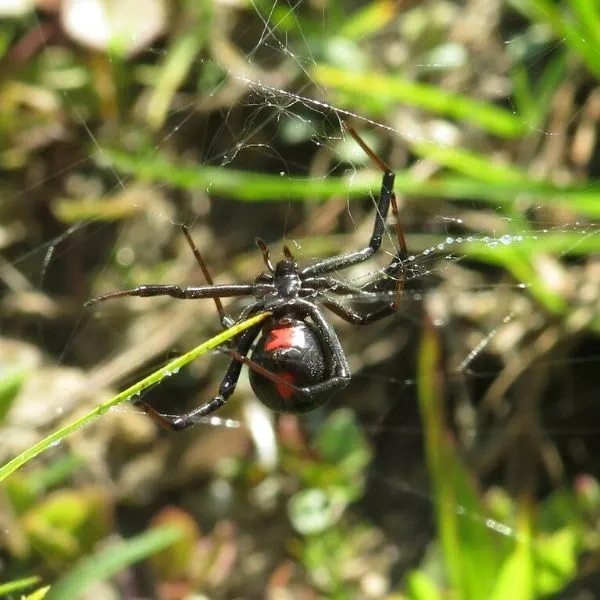
- Experience Level: Intermediate
- Family: Theridiidae
- Scientific Name: Latrodectus mactans
- Other Names: Shoe-button spider
- Adult Size: 8 to 13 mm (0.3 to 0.5 inches)
- Lifespan: 1 to 3 years
- Average Price Range: $20
Southern black widows are a member of the widow family and are a common species found in the warmer months of the year. This species is found in the southeastern United States and is active most in summer and fall.
Southern black widows create messy webs to live in. Their silk is extremely strong and is many times stronger than most species that live in Michigan.
This spider has jet black coloring, with a bright red hourglass on the bottom of its abdomen. They have large round abdomens, with spindly legs.
When most people think of a black widow they picture a female, since males are not seen often. Male black widows are much smaller in size and have long thin legs. Males have red, white, and black coloring.
Southern black widows have some of the strongest venoms amongst spiders in Michigan. Swelling, muscle spasms, nausea, and body aches may occur if bitten. While medical treatment may be needed, this spider bite is rarely deadly.
The bite of a black widow is used most to neutralize its prey. Flies, caterpillars, mosquitoes, and grasshoppers are some of the insects this spider eats.
When prey gets caught in their web, they use their legs to wrap them up in a silken cocoon, then bite them.
34. Common Candy Striped Spider
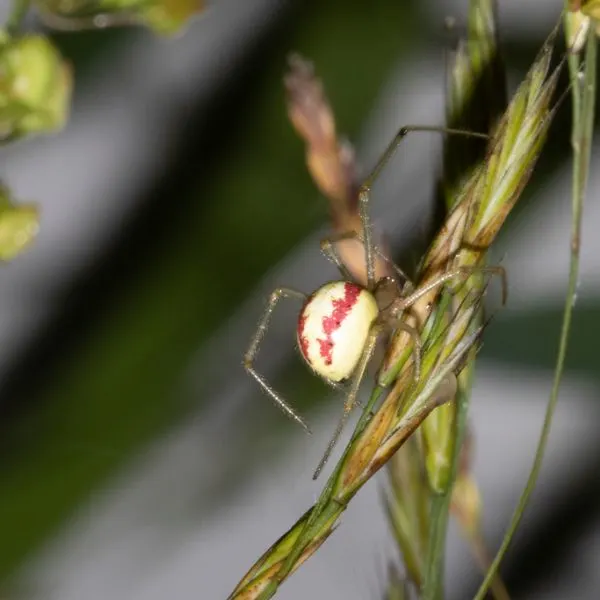
- Experience Level: Beginner
- Family: Theridiidae
- Scientific Name: Enoplognatha ovata
- Other Names: n/a
- Adult Size: 3.5 to 7 mm ( 0.13 to 0.27 inches)
- Lifespan: 1 year
- Average Price Range: n/a
Common candy striped spiders are a species native to Europe but have been introduced to North America. In the United States, this spider has managed to spread its presence in the northern and eastern areas of the country.
This spider builds messy cobwebs to live in. Common candy striped spiders are active in the summer and fall, and prefer warmer temperatures. Vegetation is where this spider creates its home, living on various leafed plants.
Common candy-striped spiders are small, with females being slightly larger. They have a light cream, yellow, or white coloring.
The legs and head of this species are a translucent beige color. They have a dark red marking on their abdomen, with a cream blotch in it.
Candy-striped spiders have a similar body shape to other Theridiidae spiders, having a plump abdomen and spindly legs.
This spider feeds on a variety of small insects. While they create small messy webs, it is not uncommon for this species to wander and look for food.
The venom of this spider is similar to that of other widow spiders, but their small fangs only produce small amounts. If bitten, swelling and pain are common symptoms, but like other spiders death is extremely unlikely.
35. Triangulate Cobweb Spider
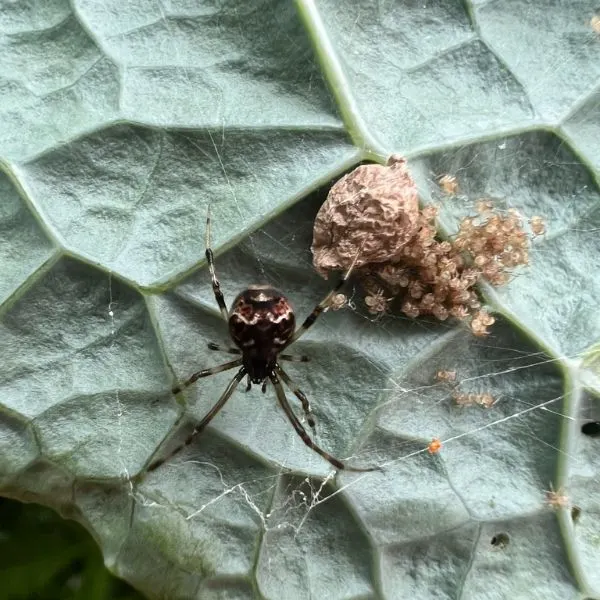
- Experience Level: Intermediate
- Family: Theridiidae
- Scientific Name: Steatoda triangulosa
- Other Names: Triangulate bud spider
- Adult Size: 3 to 6 mm (0.1 to 0.23 inches)
- Lifespan: 1 to 3 years
- Average Price Range: n/a
Triangulate cobweb spiders are a common spider in North America, Russia, New Zealand, and Europe. This spider builds a messy web, as it has very poor eyesight.
Since this spider cannot see well, it relies on the vibrations of its web to navigate the world around it. Triangulate cobweb spiders live in man-made structures, and create their webs in dark and secluded areas.
Triangulate cobweb spiders have large round abdomens and long legs. Tan, dark brown, and orangish brown are the colors this spider is seen in. They have cream and brown mottled patterns on their body.
Their legs have dark brown and orangish bands running down them. Small hairs cover this spider’s body, helping them easily move around their web.
This small species is active year-round, and spend most of its life sitting on its web. Mostly active at night, that is when they spend their time hunting. Insects like ants, beetles, flies, and other small insects are what this species eats.
The venom of the triangulate cobweb spider is used to neutralize its prey, but on some occasions, they may bite humans. Symptoms like redness and swelling are common, but bites from this spider are uncommon.
36. False Widow

- Experience Level: Beginner
- Family: Theridiidae
- Scientific Name: Steatoda grossa
- Other Names: brown house spider, cupboard spider
- Adult Size: 10 to 14 mm (0.39 to 0.55 inches)
- Lifespan: 2 to 6 years
- Average Price Range: n/a
False widows are often confused for the infamous black widow, but they are a different species. Both spiders are a part of the tangle web family of spiders, which is called Theridiidae.
False widows are common around the world, living in Europe, North America, and Australasia. This species is found across the United States and is a common species in Michigan.
False widows are cobweb spiders, creating a tangle of webs to live in. False widow webs are often made near and around man-made structures. This species also makes its web inside homes, with its web, suspended a few inches off the ground.
Steatoda grossa is commonly mistaken for the black widow because of its dark coloring, and body shape. Females have large round abdomens, while males are much smaller.
While not black, this spider has dark brown or reddish brown coloring. Some of these spiders have cream-colored markings on their body, while others are all darkly colored.
The bite from the false widow is not as dangerous as that of the black widow, but their venom still has effects. Pain, fever, swelling, and muscle spasms are some of the effects their venom has on humans.
Bites do occur, but their venom is mostly used on the insects they eat.
37. Bowl and Doily Spider
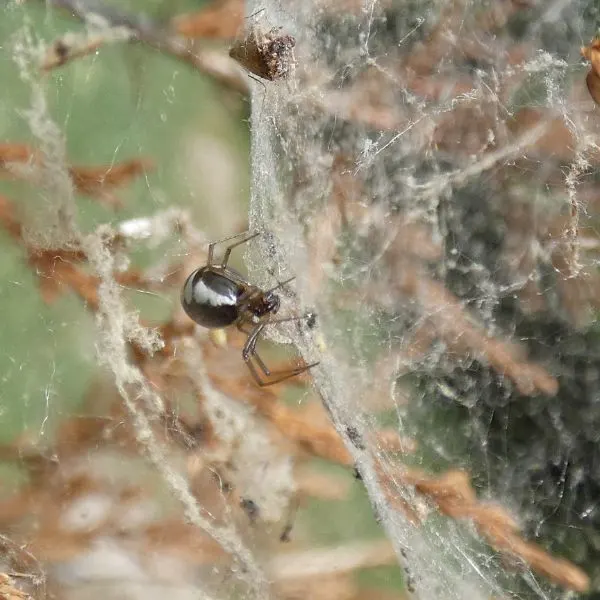
- Experience Level: Intermediate
- Family: Linyphiidae
- Scientific Name: Frontinella pyramitela
- Other Names: n/a
- Adult Size: 4 mm (0.16 inches)
- Lifespan: 1 year
- Average Price Range: n/a
In North America, and Central America lives the Bowl and doily spider, and common species found in its region. This spider is common in Michigan and across North America, inhabiting woodland and forest habitats.
Spring to fall is when this spider is most active. Bowl and doily spiders have a unique web design, which makes them easy to identify. It is common for this spider to live with others, creating a communal web.
This spider creates its web suspended in the air horizontally, usually attached to nearby vegetation. The bowl section of this spider is where it sits, in the bowl-shaped part of its web, which is near the bottom.
A sheet of sticky webbing called the doily is below the bowl part, catching most of the insects. This web design keeps the spider safe when injecting the venom into its prey.
Bowl and doily spiders are small in size, with reddish or brown coloring. They have rounded abdomens and long spindly legs. White dots cover their body, as well as tiny hairs.
Insects are the main food source of this spider. Flying insects like flies, and small gnats are what this species eats most.
Birds and lizards are the main predators of this species, as well as other larger spiders.
38. Long-bodied Cellar Spider

- Experience Level: Intermediate
- Family: Pholcidae
- Scientific Name: Pholcus phalangioides
- Other Names: Skull spider, Daddy long-leg spider
- Adult Size: 6 to 10 mm (0.23 to 3.9 inches)
- Lifespan: 0.5 to 2 years
- Average Price Range: n/a
Long-bodied cellar spiders are one of the most common in Michigan and are also found across the United States. This spider is active year-round, but many die in the colder periods of the year.
Warm months like summer and fall provide the climate they prefer to live in. In cold periods they will move indoors to survive, and often make their home in man-made structures.
This spider creates messy webs, preferably in dark and secluded areas. It is common for this spider to live with others of the same species in a communal web. Long-bodied cellar spiders have long skinny legs, and small abdomens.
Another common name for this species is the skull spider since their heads look like human skulls. This species has tan coloring, with dark bands on its legs.
Long-bodied cellar spiders sit in their web most of their life. Their webs are loosely made and catch flying insects like flies, and crane flies.
When something gets caught in their web they wrap them up in silk quickly, using their long legs. Many people keep this spider around to feed on pest insects and other more dangerous spiders.
Like most spiders, they are venomous and use it to neutralize their prey. Bites do not occur often in humans, as their fangs are too small to puncture the skin.
39. American Green Crab Spider

- Experience Level: Beginner
- Family: Thomisidae
- Scientific Name: Misumessus oblongus
- Other Names: n/a
- Adult Size: 3 to 6.8 mm (0.12 to 0.27 inches)
- Lifespan: 1 year
- Average Price Range: n/a
American green crab spiders are common in woodlands, forests, and meadow-type habitats. This spider lives in the US, Mexico, and parts of Canada.
This species does not make webs and only uses its silk to make egg sacs, travel, or mate. Spring to fall is when this spider is active.
Males use their silk to tie up females to safely mate and avoid being eaten. Females create egg sacs in the vegetation they are living on and die shortly after laying them.
American green crab spiders have long legs, and a yellow-green coloring to help them blend into their environment. This species looks translucent, with reddish brown markings on its back. Females are much larger than males and are near twice the size.
This species wanders around for food, preying on small insects they come across. American green crab spiders are active during the day and spend their time hunting during this period.
Using their long legs they grab their prey and use their strong grip to prevent them from escaping. Ants, crickets, grasshoppers, millipedes, and wasps are some of the things they hunt.
Being active during the day this species is eaten by animals like lizards, birds, and larger spiders.
40. Northern Crab Spider

- Experience Level: Beginner
- Family: Thomisidae
- Scientific Name: Mecaphesa asperata
- Other Names: n/a
- Adult Size: 3.5 to 7 mm (0.13 to 0.27 inches)
- Lifespan: 1 year
- Average Price Range: n/a
Northern crab spiders live across Europe, Asia, and North America. This species is a flowered spider and uses flowering plants for shelter and food.
Meadows, woodlands, grasslands, and marshes are habitats this species lives in. Northern crab spiders sit on flowers waiting for food to come by and use their camouflage to stay hidden.
They are active during the day when most of their prey is out. Males are much more of a wandering species and spend their life looking for a mate.
Northern crab spiders come in a variety of colors like green, yellow, and white. They have dark markings on their abdomen, and legs.
Small hairs also cover their body. Northern crab spiders belong to the family of Thomisidae, also called the crab spider family, and get their name from their long legs and crab-like appearance.
The colors of this species match the surrounding, and they are able to change their shade over a long period of time.
Northern crab spiders feed on pollinator insects like bees, flies, butterflies, aphids, grasshoppers, and wasps. Even though this species is well hidden, and has good camouflage it still has many natural predators.
Ants, wasps, lizards, and birds are the main animals that hunt this species.
41. Goldenrod Crab Spider
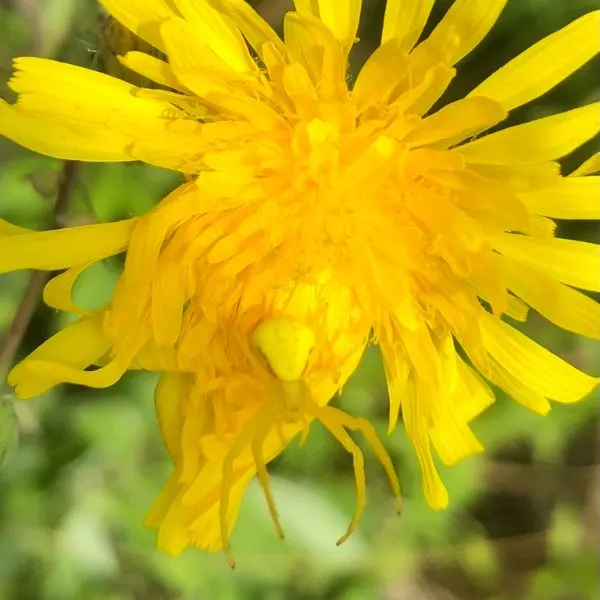
- Experience Level: Beginner
- Family: Thomisidae
- Scientific Name: Misumena vatia
- Other Names: Flower crab spider
- Adult Size: 5 to 10 mm (0.20 to 0.39 inches)
- Lifespan: 1 year
- Average Price Range: n/a
The goldenrod crab spider lives in Michigan and is a common species in North America. This spider lives in forested areas with vegetation fit for them to live on.
The plants they inhabit most often are milkweed and goldenrod, using the plant for shelter. Females spend most of their life on flowers and are attracted to the scents put off by them. Males are extremely active, spending most of their life looking for a mate.
Goldenrod crab spiders are usually yellow or white, with vibrant coloring. They are able to change between these two colors to help blend into their habitat, but it is over the course of a long period of time.
Goldenrod crab spider females have a large rounded abdomen, with spindly legs. Males are much smaller than females and have long legs. Their smaller abdomens are rounded, and their legs have a dark brown coloring.
Goldenrod crab spiders primarily feed on the pollinators that come close to the flower they sit on. They use their coloring to camouflage from their prey and use their two front legs to grip their food.
Bees, butterflies, and moths are the most common food for this species.
42. White-banded Crab Spider
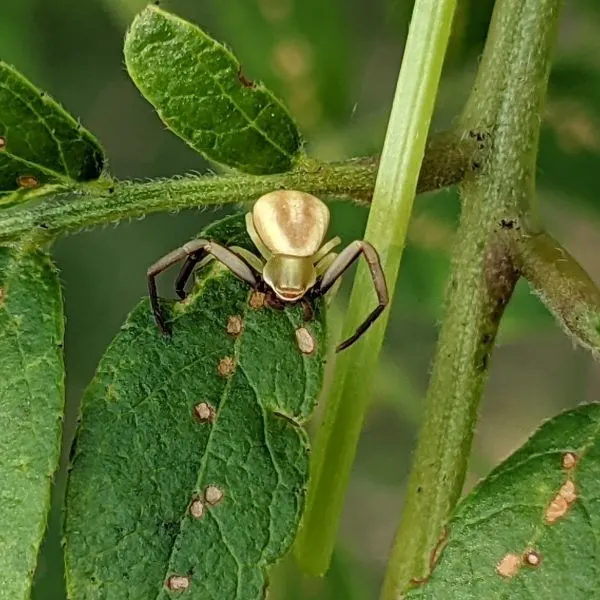
- Experience Level: Intermediate
- Family: Thomisidae
- Scientific Name: Misumenoides formosipes
- Other Names: n/a
- Adult Size: 3 to 11 mm (0.11 to 0.43 inches)
- Lifespan: 1 year
- Average Price Range: n/a
White-banded crab spiders are a species found in Michigan and are common in the northeastern United States. This spider is most active in the late summer and fall.
Fields, pastures, gardens, and meadows are the habitats this species lives in. They inhabit a variety of vegetation like milkweeds, daisies, thistles, and other flowering plants.
Females spend most of their life on vegetation, using it for shelter and food. Males wander around and look for a female to mate with.
After mating females create an egg sac and continue to do so until the winter. This species dies when winter comes, and their eggs overwinter until the next spring.
Like other similar species, this spider body resembles a crab. The white-banded crab spider comes in white, yellow, and tan colors.
On their body is reddish, or purple, and black markings on them. This species gets its name and is recognizable by the white band that runs across its carapace.
A rare trait in spiders, this species is able to change colors to better fit into its surroundings. Males are much smaller in size than females and have a golden body with long legs.
This spider feeds on pollinating insects and ambushes them when they come close to their home. The coloring helps them camouflage, and their strong two front legs help them grab their prey.
43. Giant House Spider

- Experience Level: Beginner
- Family: Agelenidae
- Scientific Name: Eratigena atrica
- Other Names: n/a
- Adult Size: 12 to 18 mm (0.47 to 0.73 inches)
- Lifespan: 2 to 3 years
- Average Price Range: n/a
Giant house spiders are a very common species to find in Michigan.
Very common in Central and Northern Europe, this spider has a very small range within the United States. Being a house spider this species builds its near, or in man-made structures.
The webbing they create is flat and messy, with a funnel-like entrance. The corners of basements, around boxes, and in attics are frequent places this spider is seen.
Females of this species only leave their web to eat, but males are much more active. Spring to fall is when this spider is active.
In the summer males wander around looking for a mate. When mating is successful females create an egg sac, usually holding around 60 or more spiderlings.
Giant house spiders are one of the largest spiders in their region. This species has a tan, or reddish brown coloring, with dark markings on them.
The legs of this spider are its biggest feature and stretch out the side of its body. Hairs cover the entire body of this species. Females and males have similar appearances, but males are slightly smaller in size.
Giant house spiders feed on a variety of insects like flies, roaches, and mosquitoes. Venom is used by this species to neutralize its prey.
Bites from humans have mild effects, and their fangs are strong enough to pierce skins. A generally harmless species, this species is most active at night.
44. Eastern Parsons Spider

- Experience Level: Intermediate
- Family: Gnaphosidae
- Scientific Name: Herpyllus ecclesiasticus
- Other Names: n/a
- Adult Size: 5 to 12.7 mm (0.2 to 0.5 inches)
- Lifespan: 1 to 2 years
- Average Price Range: n/a
Eastern parsons spiders live in the eastern United States. They are a ground-dwelling species, being most active at night.
Many times the eastern parson spider is found hiding under natural debris like logs or rocks. They occasionally make their way indoors, looking for food or shelter.
The parson’s spider is dark brown or black, with a cream-colored stripe running across its body. A small white marking also appears right above its spinneret.
Its legs are long and thick, helping it traverse the various habitats it lives in. Small hairs cover this spider’s body. This species is nearly identical to the western parson spider (Herpyllus propinquus), but that species is only seen in the western United States.
The eastern parson spider venom is non-lethal, but useful in taking out the small prey it hunts. Various insects are eaten and hunted down by this spider.
They may even feed on other spiders that are smaller than them. When not actively hunting this spider creates a silk retreat to hide in, similar to that of a sac spider.
45. Long-Legged Yellow Sac Spider

- Experience Level: Intermediate
- Family: Clubionidae
- Scientific Name: Cheiracanthium mildeiSa
- Other Names: Northern Yellow Sac Spider
- Adult Size: 5 to 10 mm (0.19 to 0.39 inches)
- Lifespan: 1 to 2 years
- Average Price Range: n/a
The long-legged sac spider is a species native to Europe, and North Africa. This spider is now common in the northeastern United States, and parts of Canada.
They are most active in the spring and early summer, becoming more uncommon as the year goes on. This species lives in a variety of different habitats. Areas with leaf litter, stones, boards, and other areas where they can hide are where this species is seen most often.
Long-legged yellow sac spiders are also seen in homes. Being primarily nocturnal most of this species’ time is spent hiding.
This spider creates a silken tent retreat to hide in, similar to other sac spiders. They may also hide in corners and other secluded areas.
If this species is found in your home it is best to keep the house clean to prevent them. Hiding places like laundry on the ground, or other debris is where they will hide.
This species has a pale cream or tannish color. They have extremely long front legs, with black coloring on the tips of their feet. Long-legged sac spiders have a rounded abdomen, covered in a mottled pattern.
The fangs from this species are extremely large and help produce a painful bite. When hunting at night this spider eats other spiders, insects, and larvae.
Getting bit by this spider occurs more than other species since they are one of the most common spiders in homes. Swelling, itchiness, and mild necrosis may occur.
While their venom is mildly necrotic, death does not occur.
46. Broad-faced Sac Spider
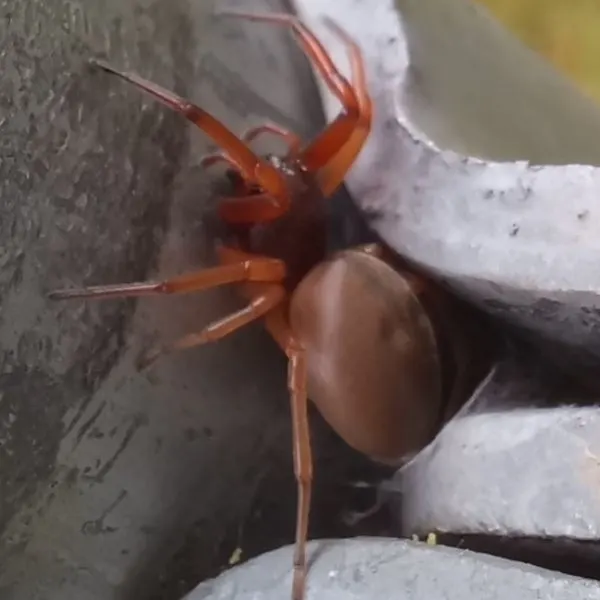
- Experience Level: Intermediate
- Family: Trachelidae
- Scientific Name: Trachelas tranquillus
- Other Names: n/a
- Adult Size: 5 to 10 mm (0.19 to 0.39 inches)
- Lifespan: 1 to 2 years
- Average Price Range: n/a
Broad-faced sac spiders live in dry and warm habitats. They are most common in the summer and autumn periods.
At night is when they are active and hunt. During the day this spider creates a silken tent-like retreat. This spider is only found in the Eastern US.
Under rocks and natural debris is where this species can be found during the day. They are sometimes seen in window sills, and will occasionally even make their way into your home.
Broad Faced sac spiders are a small species, with females being slightly larger. They have a black carapace, with reddish brown legs.
The two front legs of this species are slightly larger than the rest of its legs. The abdomen of this spider is rounded, with tan coloring. Some specimens have a light dorsal stripe running down their back.
Broad Faced sac spiders are sometimes seen as pests, but they are harmless. Their venom is only helpful to the small insects they feed on.
This spider is a scavenger, mostly feeding on dead insects. They also eat mites, and other spiders they come across.
The bite from this species is harmless, but since the broad-faced sac spider eats on dead animals, if bitten you should clean the area. Large fangs may make a bite painful and come with slight swelling.
47. Woodlouse Hunter

- Experience Level: Beginner
- Family: Dysderidae
- Scientific Name: Dysdera crocata
- Other Names: Woodlouse hunter, sowbug killer
- Adult Size: 9 to 3 mm (0.35 to 0.59 inches)
- Lifespan: 2 to 5 years
- Average Price Range: n/a
A spider found all across the US, woodlouse hunters are a very common species in Michigan. This spider gets its name from its eating habits, feeding mostly on woodlouse.
They are often found in the same habitats as woodlouse, staying close to their food source. In moist areas with rotting natural debris is where this spider can be found.
Woodlouse spiders are active at night and hide in crevices during the day. A silken retreat is made for them to rest in. They are active year-round but are most commonly seen in the spring.
Woodlouse spiders have a large rounded tan abdomen, with a reddish head. Their reddish legs are long and it helps them traverse the ground.
This species has large chelicerae, which help bite through the tough exoskeleton of the woodlouse. Females are slightly larger than males. Unlike other spiders, woodlouse hunters only have six eyes.
Woodlice are the main insects this spider feeds on, but they also feed on other small insects they may come across. They hunt at night and use mild venom to neutralize their prey.
The bite of this spider is harmless to humans and is less painful than a bee sting. When not hunting this spider is in a silken retreat. They also lay their eggs in these sacs after breeding.
48. Western Lynx Spider

- Experience Level: Intermediate
- Family: Oxyopidae
- Scientific Name: Oxyopes scalaris
- Other Names: n/a
- Adult Size: 4 to 16 mm (0.15 to 0.62 inches)
- Lifespan: 1 year
- Average Price Range: n/a
A common spider across the United States, Western Lynx spiders are a diurnal species you can find in Michigan. Known scientifically as Oxyopes scalaris, they are more common in the western United States.
It has a scattered population in the eastern United States. Lynx spiders do not sit in webs but roam about during the day. This species becomes inactive at night, hiding in secluded areas like under rocks and foliage.
Western lynx spiders are medium-sized, and tan in color. Like other lynx spiders, they have thick spines coming out of their legs.
This spider has dark brown, white, and light tan coloring on its body. The sexes of this species have a very similar appearance, but males are slightly dark in color and have large pedipalps.
Oftentimes this spider is found wandering about near foliage and wandering about. This species is an active hunter, and like a species of jumping spider, they are reliant on their good vision.
Western Lynx spiders have better eyesight than most insects and spiders. They feed on flies, other small insects, and various small spiders.
Being active in the day the Western Lynx spider faces many predators like wasps, reptiles, birds, and small mammals. Like most spiders the bite and venom of this species are harmless.
49. Spitting Spider
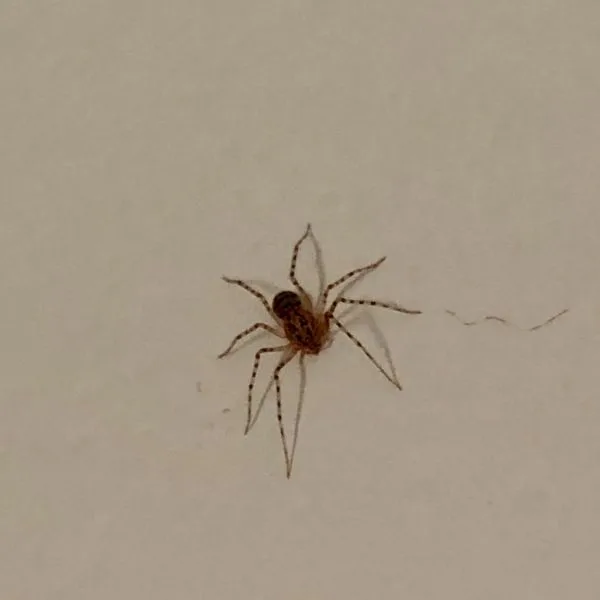
- Experience Level: Intermediate
- Family: Scytodidae
- Scientific Name: Scytodes thoracica
- Other Names: n/a
- Adult Size: 6 to 18 mm (0.25 to 0.75 inches)
- Lifespan: 1.5 to 4 years
- Average Price Range: $30
The spitting spider is a common species in the United States, and like its name suggests it is known for its ability to spit at its prey.
These spiders have a large range also found in Europe, North America, India, New Zealand, Japan, Kora, and parts of Asia. Spitting spiders live in warm habitats, and tend to be more active at night.
During the day they hide in dark areas like under rocks, and logs. It is common for this species to make its way into homes at night looking for food.
Spitting spiders have a round head and abdomen. They are gray in color, with long thin legs.
Black markings appear over this species’ body, and they have dark bands running down their legs. Unlike most species of spiders, the spitting spider only has 6 eyes, placed in groups of two on their face. When walking this spider puts its longest legs out front, and uses them as a way to aim at its prey.
This species uses liquid venom and silk to capture its prey. The venom and silk this spider spit outcomes out fast, at around 1/700th of a second.
It can spit up to an inch, and gets its prey trapped in an entanglement of webs. Flies, mosquitoes, and other spiders are what this species feeds on. They are harmless to humans, with very weak venom.
FAQ
What Is The Largest Spider In Michigan?
Wolf spiders are the largest type of spider that lives in Michigan. The largest wolf spider is the Carolina wolf spider, which is a species that inhabits Michigan.
Wolf spiders are known for their size, and hunting ability. They vary in size, but most wolf spiders are much larger than the average spider.
What Spiders In Michigan Are Most Common?
On this list, you will find the most common spiders, but some species are seen more often than others.
Cellar spiders, house spiders, and other species that are active year-round are what are most commonly found in the state. Spiders that live in homes are able to be active and breed year-round since they are not affected by the season changes that occur throughout the year.
When Are Spiders Most Active In Michigan?
Spring to summer is when spiders are most active in Michigan.
When winter comes along the cold kills off the mature spiders that hatched earlier in the year. Eggs and spiderlings overwinter when the cold comes, and wait for the next spring to come along.
In Michigan, What Spiders Are The Most Dangerous?
The black widows and brown recluses are the most dangerous spiders that live in Michigan.
Their venom is potent, but deaths from these species are rare. Black widows are much more common in Michigan, as the brown recluse has only been sighted in a few select counties.
Wrapping up
Michigan is home to hundreds of spider species, and each of them is extremely important in keeping a balanced ecosystem.
Almost all spiders primarily feed on insects, and they are some of the best animals in maintaining, and controlling the insect population. Spiders that live in gardens, and farms are great at killing the pest insects that feed on plants.
Feeding insects are not the only importance that spiders have in the wild, but they are also an important food source to a wide range of animals. Birds, frogs, and small mammals are just some of the animals that use spiders as a food source.
Michigan spiders help keep balance in the natural world. There are many species to appreciate, and the 49 on this list are just a small portion to be found in the world.
Keeping a spider as a pet is not uncommon, and there are many species in the state that make a great pet. Most do not live very long, but it is always a treat to watch and learn about the different spiders of the world.
More spiders in nearby states
